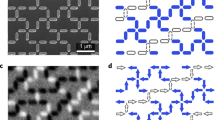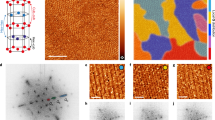Abstract
The large degeneracy of states resulting from the geometrical frustration of competing interactions is an essential ingredient of important problems in fields as diverse as magnetism1, protein folding2 and neural networks3. As first explained by Pauling4, geometrical frustration of proton positions is also responsible for the unusual low-temperature thermodynamics of ice and its measured ‘ground state’ entropy5. Recent work has shown that the geometrical frustration of ice is mimicked by Dy2Ti2O7, a site-ordered magnetic material in which the spins reside on a lattice of corner-sharing tetrahedra where they form an unusual magnetic ground state known as ‘spin ice’6,7,8,9,10,11,12,13. Here we identify a cooperative spin-freezing transition leading to the spin-ice ground state in Dy2Ti2O7. This transition is associated with a very narrow range of relaxation times, and represents a new form of spin-freezing. The dynamics are analogous to those associated with the freezing of protons in ice, and they provide a means through which to study glass-like behaviour and the consequences of frustration in the limit of low disorder.
This is a preview of subscription content, access via your institution
Access options
Subscribe to this journal
Receive 51 print issues and online access
$199.00 per year
only $3.90 per issue
Buy this article
- Purchase on Springer Link
- Instant access to full article PDF
Prices may be subject to local taxes which are calculated during checkout





Similar content being viewed by others
References
Ramirez, A. P. in Handbook of Magnetic Materials Vol. 13 (ed. Buschow, K. J. H.) 423–520 (Elsevier Science, Amsterdam, 2001).
Onuchic, J. N., Luthey-Schulten, Z. & Wolynes, P. G. Theory of protein folding: The energy landscape perspective. Ann. Rev. Phys. Chem. 48, 545–600 (1997).
Hopfield, J. J. Neurons with graded response have collective computational properties like those of two-state neurons. Proc. Natl Acad. Sci. 81, 3088–3092 (1984).
Pauling, L. The Nature of the Chemical Bond 301–304 (Cornell Univ. Press, Ithaca, New York, 1945).
Petrenko, V. F. & Whitworth, R. W. Physics of Ice (Clarendon, Oxford, 1999).
Harris, M. J., Bramwell, S. T., McMorrow, D. F., Zeiske, T. & Godfrey, K. W. Geometrical frustration in the ferromagnetic pyrochlore Ho2Ti2O7. Phys. Rev. Lett. 79, 2554–2557 (1997).
Harris, M. J., Bramwell, S. T., Holdsworth, P. C. W. & Champion, J. D. M. Liquid-gas critical behaviour in a frustrated pyrochlore ferromagnet. Phys. Rev. Lett. 81, 4496–4499 (1998).
Bramwell, S. T. & Harris, M. J. Frustration in Ising-type spin models on the pyrochlore lattice. J. Phys. Condens. Matter 10, L215–L220 (1998).
Ramirez, A. P., Hayashi, A., Cava, R. J., Siddharthan, R. & Shastry, B. S. Zero-point entropy in ‘spin ice’. Nature 399, 333–335 (1999).
Harris, M. J. Taking the frustration out of ice. Nature 399, 311–312 (1999).
Siddharthan, R. et al. Ising pyrochlore magnets: low-temperature properties, “ice rules,” and beyond. Phys. Rev. Lett. 83, 1854–1857 (1999).
den Hertog, B. C., Melko, R. G. & Gingras, M. J. P. Long range order at low temperature in dipolar spin ice. Preprint cond-mat/0009225 at 〈http://xxx.lanl.gov〉 (2000).
Gingras, M. J. P. & den Hertog, B. C. Origin of spin ice behavior in Ising pyrochlore magnets with long range dipole interactions: an insight from mean-field theory. Preprint cond-mat/0012275 at 〈http://xxx.lanl.gov〉 (2000).
Kawada, S. Dielectric anisotropy in ice Ih. J. Phys. Soc. Jpn 44, 1881–1886 (1978).
Haida, O., Matsuo, T., Hiroshi, S. & Seki, S. Calorimetric study of the glassy state X. Enthalpy relaxation at the glass-transition temperature of hexagonal ice. J. Chem. Thermodyn. 6, 815–825 (1974).
Giaque, W. F. & Stout, J. W. The entropy of water and the third law of thermodynamics. The heat capacity of ice from 15K to 273K. J. Am. Chem. Soc. 58, 1144–1150 (1936).
Rosenkranz, S. et al. Crystal-field interaction in the pyrochlore magnet Ho2Ti2O7. J. Appl. Phys. 87, 5914–5916 (2000).
Ramirez, A. P., Espinosa, G. P. & Cooper, A. S. Strong frustration and dilution enhanced order in a quasi-2D spin glass. Phys. Rev. Lett. 64, 2070–2073 (1990).
Gardner, J. S. Glassy statics and dynamics in the chemically ordered pyrochlore anti-ferromagnet Y2Mo2O7. Phys. Rev. Lett. 83, 211–215 (1999).
Schiffer, P. et al. Frustration induced spin freezing in a site-ordered magnet—gadolinium gallium garnet. Phys. Rev. Lett. 74, 2379–2382 (1995).
Wills, A. S. Long range ordering and representational analysis of the jarosites. Phys. Rev. B 63, 064430-1–064430-12 (2001).
Mydosh, J. A. Spin Glasses: An Experimental Introduction (Taylor & Francis, London, 1993).
Reich, D. H., Rosenbaum, T. F. & Aeppli, G. Glassy relaxation without freezing in a random dipolar-coupled Ising magnet. Phys. Rev. Lett. 59, 1969–1972 (1987).
Fiorani, D., Tholence, J. & Dorman, J. L. Magnetic properties of small ferromagnetic particles (Fe-Al2O3 granular thin films): Comparison with spin glass properties. J. Phys. C 19, 5495–5507 (1986).
Casimir, H. B. G. & du Pré, F. K. Note on the thermodynamic interpretation of paramagnetic relaxation phenomena. Physica 5, 507–511 (1938).
Dirkmaat, A. J. et al. Frequency-dependence of the ac susceptibility in the random anisotropy system Dy(P1-xVx)O4. Phys. Rev. B 36, 352–359 (1987).
Huser, D., Wenger, L. E., van Duyneveldt, A. J. & Mydosh, J. A. Dynamical behavior of the susceptibility around the freezing temperature in (Eu,Sr)S. Phys. Rev. B 27, 3100–3103 (1983).
Dekker, C., Arts, A. F. M., de Wijn, H. W., van Duyneveldt, A. J. & Mydosh, J. A. Activated dynamics in a two-dimensional Ising spin glass: Rb2Cu1-xCoxF4. Phys. Rev. B 40, 243–251 (1989).
Bramwell, S. T. et al. Spin correlations in Ho2Ti2O7: A dipolar spin ice system. Phys. Rev. Lett. 87, 047205-1–047205-4 (2001).
Matsuhira, K., Hinatsu, Y., Tenya, K. & Sakakibara, T. Low temperature magnetic properties of frustrated pyrochlore ferromagnets Ho2Sn2O7 and Ho2Ti2O7. J. Phys. Condens. Matter 12, L649–L656 (2000).
Matsuhira, K., Hinatsu, Y. & Sakakibara, T. Novel dynamical magnetic properties in the spin ice compound Dy2Ti2O7. J. Phys. Condens. Matter 13, L737 (2001).
Acknowledgements
We thank D.A. Huse, T. Rosenbaum and J. Banavar for discussions. This work was supported by the Army Research Office.
Author information
Authors and Affiliations
Corresponding author
Rights and permissions
About this article
Cite this article
Snyder, J., Slusky, J., Cava, R. et al. How ‘spin ice’ freezes. Nature 413, 48–51 (2001). https://doi.org/10.1038/35092516
Received:
Accepted:
Issue Date:
DOI: https://doi.org/10.1038/35092516
This article is cited by
-
Internal friction behavior of Ni50.5Mn25Ga24.5 alloy with cellular microstructure
Rare Metals (2023)
-
Monopole matter from magnetoelastic coupling in the Ising pyrochlore
Communications Physics (2021)
-
Evolution of spin freezing transition and structural, magnetic phase diagram of Dy\(_{2-\textit{x}}\)La\(_\textit{x}\)Zr\(_{2}\)O\(_{7}\) (0 \(\le\) \(\textit{x}\) \(\le\) 2.0)
Scientific Reports (2021)
-
Machine-learning-assisted insight into spin ice Dy2Ti2O7
Nature Communications (2020)
Comments
By submitting a comment you agree to abide by our Terms and Community Guidelines. If you find something abusive or that does not comply with our terms or guidelines please flag it as inappropriate.



